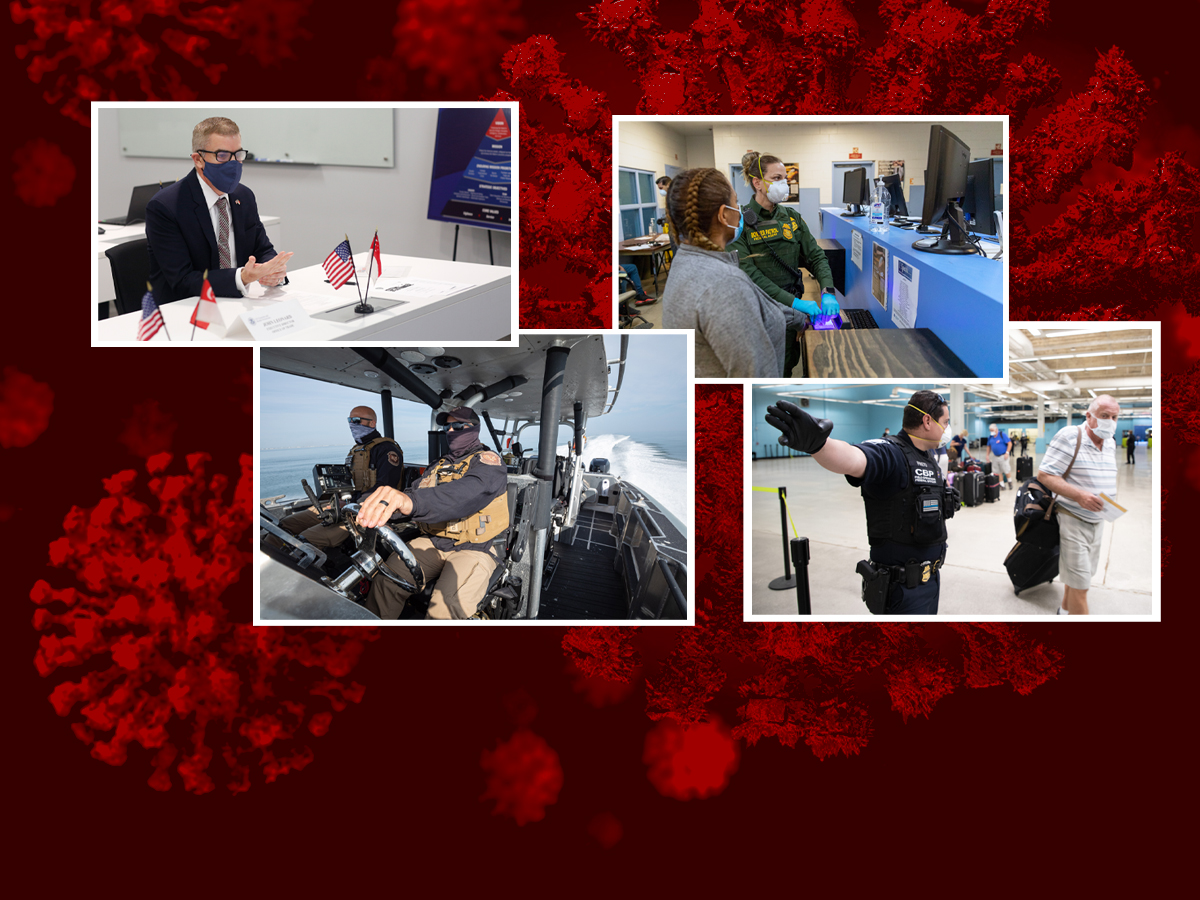
A Year Like No Other
Composite graphic by Janice Jones
In March 2020, as Border Patrol Agent Jesse Moreno walked the border between the U.S. and Mexico along the Rio Grande in South Texas, he had a lot on his mind. Although the illegal immigration numbers in 2019 that had overwhelmed Border Patrol agents from the Gulf of Mexico to the Pacific Ocean subsided, a new problem arose: the COVID-19 pandemic.
“It affected everyone in one way or another,” Moreno said, adding that along with their regular gear they have to take for a day on the border, they’re also bringing face masks and gloves – personal protective equipment – as well as taking measures to clean vehicles and work spaces and having medical screeners look at those being apprehended to slow the spread of the disease. “It’s a change in the way of life, for sure.”
He even fought a case of the virus himself, worrying that he could spread it to his wife and children. But like many in U.S. Customs and Border Protection, he persevered and carried on. “We have a mission to protect the American border and safeguard our nation, and that’s what we’re going to continue to do, regardless of outside influences.”
Across the country in Washington, D.C., William Ferrara took over in September 2020 as the executive assistant commissioner for CBP’s Office of Field Operations – the men and women who wear the blue uniforms and process international passengers arriving to the U.S. and the food and cargo that kept the nation’s wheels turning. He entered that role after serving as the executive assistant commissioner for CBP’s Operations Support. In both capacities, he worried for his people out in the field, as they, too, would face their own battles with the disease but had to keep doing their jobs.
“We had to protect our workforce, because the mission didn’t stop,” Ferrara said. “We continued to work 24 hours a day, seven days a week.”
Back in South Texas, Supervisory Aviation Enforcement Agent Lonnie Smith – who flies out of McAllen and spends his day conducting surveillance from the air and coordinating with Border Patrol agents on the ground – looked for new ways to turn the crisis into an opportunity, while keeping his fellow Air and Marine Operations agents safe, in the air and on the waters.
“The safety of our personnel is paramount,” Smith said. “It’s been a heavy lift, but we pushed through.”
These are just some of the faces of CBP, the more than 60,000 men and women who watch over this nation’s borders and facilitate legitimate trade and travel, who faced a year like no other, claiming the lives of more than 500,000 Americans – and counting – and changing how the U.S. works and plays. During the past year, COVID-19 also changed how CBP operates; some temporary changes, some that will likely become permanent. This is the story of an agency during the past year and continues to overcome all obstacles.
Patrolling a Border While Walking a Line Between Safety and Security
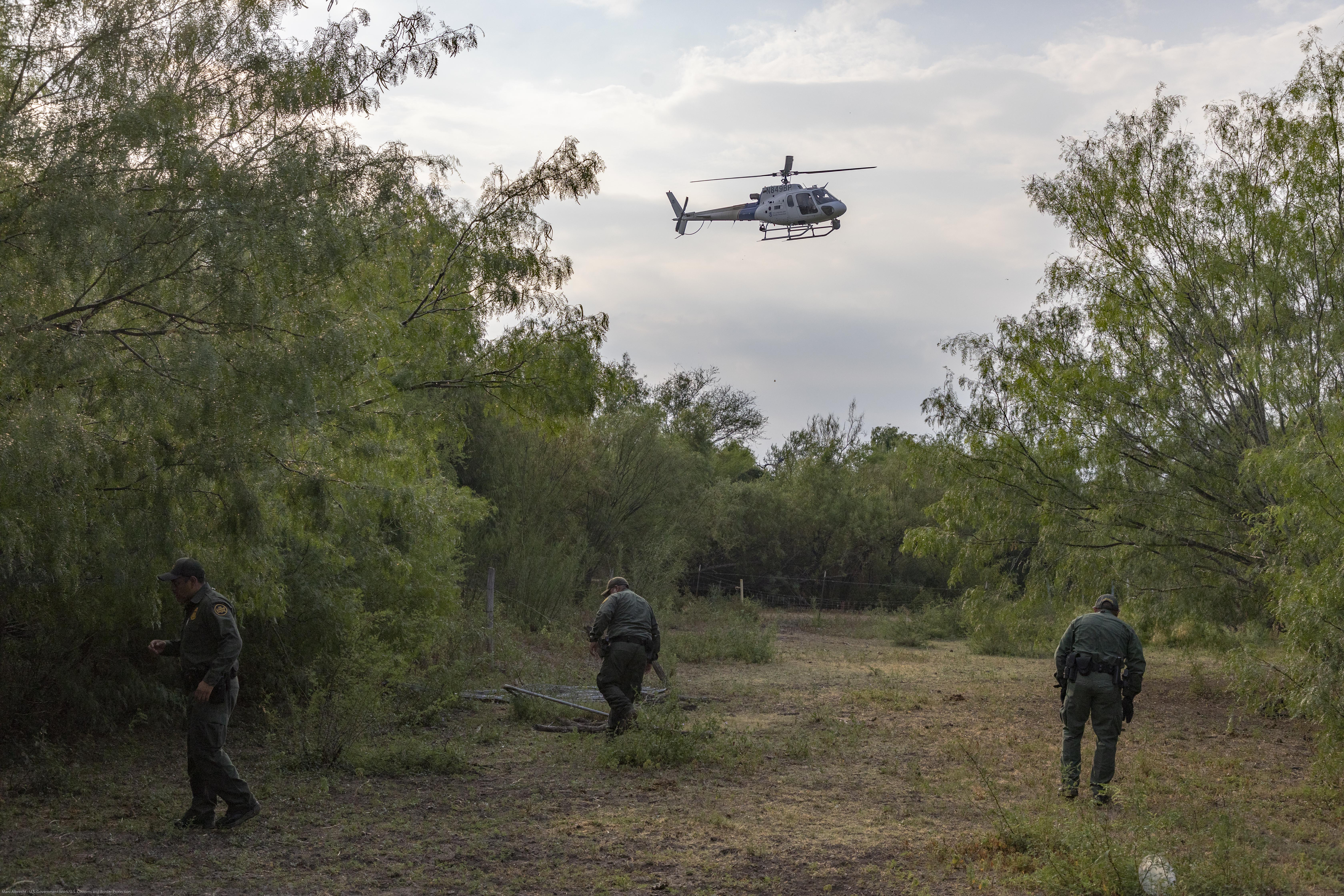
An Air and Marine Operations helicopter from the McAllen Air Branch works with Border Patrol agents tracking a group near Penitas, Texas. Photo by Rod Kise
Along the southwest border with Mexico and the U.S., Border Patrol agents faced an especially daunting task, particularly in the areas of Del Rio and McAllen, Texas. Agents had to balance stopping and processing a large amount of people who entered the country illegally without exposing fellow agents, other detainees and the public in these areas of South Texas along the Rio Grande.
Deputy Chief of the Border Patrol Raul Ortiz was in leadership positions at the sectors in that area of Texas just up until about a week or two prior to COVID-19 being declared a pandemic and right before he took over the No. 2 position for all of Border Patrol at headquarters in Washington, D.C. He knew what the people in the field needed to accomplish their mission. One of their first priorities was to manage the numbers of those they would encounter and apprehend without creating the same crowds they had seen in 2019 when hundreds of thousands of families, primarily from Central America, came across and filled Border Patrol stations, normally equipped to accommodate just single adult males.
CBP used – and continues to use – what it calls a “job hazard analysis” to evaluate risks and determine what safety measures need to be put in place for the various offices and components of the agency. Using this analysis, leadership was able to figure out what protective measures could be given to Border Patrol agents and how those who entered illegally could be handled in a safe and timely manner. Lower holding numbers and a change in how detainees were handled meant a drastic change in operations.
“The business model of having these big stations with 400 or 500 people crowded into a facility for processing and pending transfer for days on end to other agencies, you just can’t do that anymore,” Ortiz said. “Because that becomes a bit of a petri dish for what the rest of the country and the world experienced. We’ve got to be faster in our ability of moving people through the process.”
Those protective measures, along with giving surgical masks to those detained and increasing cleanings of vehicles and holding facilities, not only kept Border Patrol agents more safe, but also kept those who entered illegally more safe.
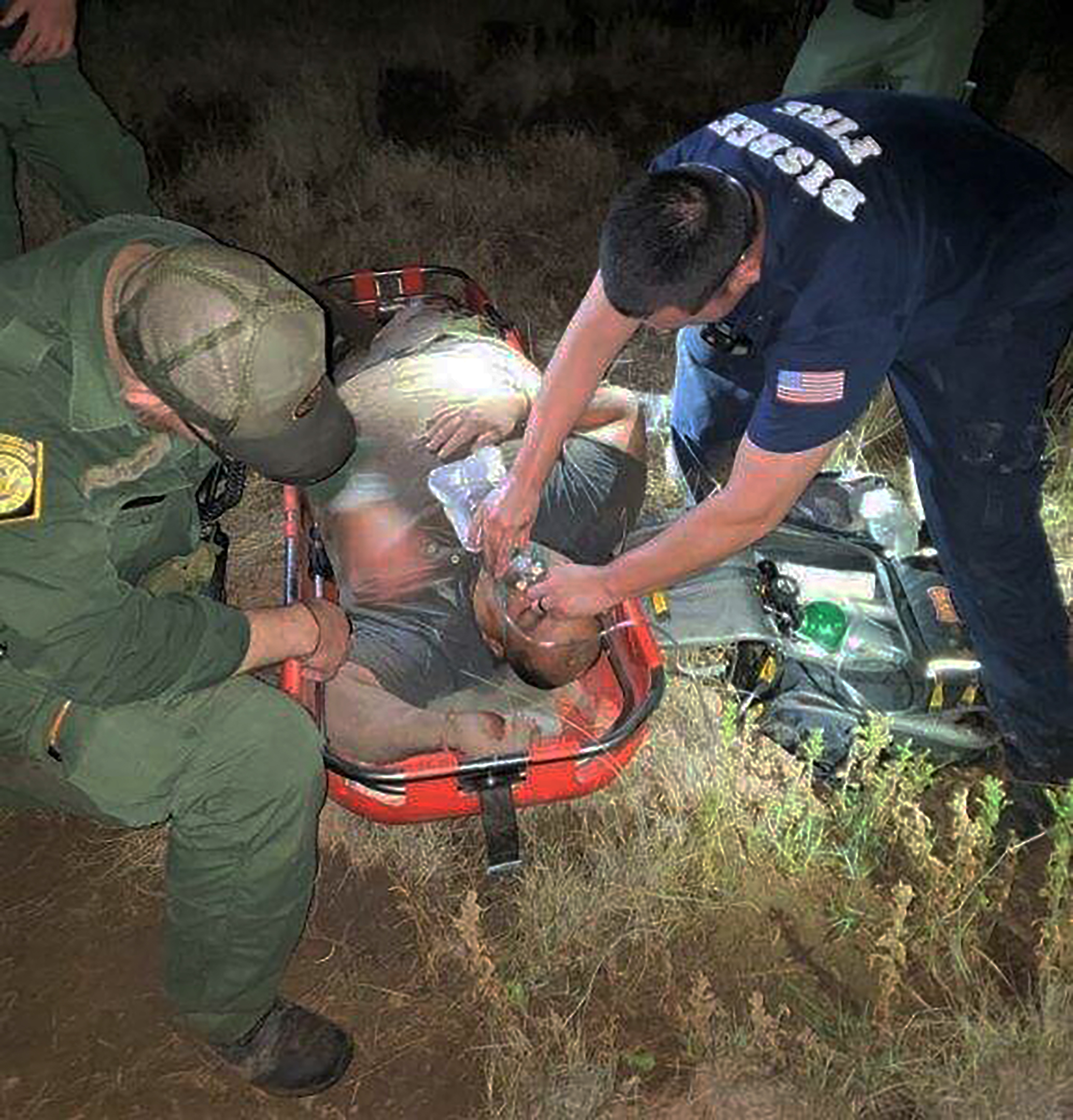
Border Patrol agents rescue a man in medical distress while patrolling the desert west of Douglas, Arizona. CBP photo
“Their health and safety is very important as well,” said Chief Patrol Agent Brian Hastings, in charge of all Border Patrol operations in the Rio Grande Valley out of Edinburg, Texas.
But facing possible infections from a variety of diseases – chicken pox, scabies and even the “regular” flu – has always been a concern for agents who patrol the border.
“There’s always a threat. This isn’t new. The people on the ground have seen multiple contagions,” Hastings said. “But this has really opened all of our eyes on the use of personal protective equipment, wearing masks and gloves, and sanitizing our vehicles and holding facilities to try to keep our agents safe and those we come into contact with safe. I see those good practices continuing well after COVID is done.”
In Del Rio, Texas, one of the hottest spots for Border Patrol during COVID-19, Supervisory Border Patrol Agent Ron Rios said while they’ve always been aware of the many threats diseases could pose, COVID added another layer of complexity to an already complex job.
“Agents are constantly engaging in law enforcement actions. They’re constantly helping with the families that come across, and still at the same time, maintaining situational awareness and vigilance the job requires,” he said. “What changed is that added threat of COVID, because you can’t see it. So they have to be aware of stopping the transmission of COVID, minimizing exposures to themselves and other agents, and how do they better protect the people in their care.”
“We talk about agility all the time and the ability to adjust to policy or guidance as it changes,” Ortiz said, pointing out that the initial job hazard analysis used to develop policies and techniques went through several revisions over the last year, “Because we recognize that conditions change. I applaud our workforce for recognizing this was a very fluid, new scenario. The Border Patrol, CBP, [Department of Homeland Security], and really our border communities did a phenomenal job of working closely with us to make sure that [Border Patrol wasn’t] the weakest point in all of this.”
Ortiz added, even as new vaccines are developed, he encouraged his people in the field not to let down their guards.
“Don’t let up. Don’t relax. Continue to use all the safety precautions out there, because we still don’t have all the information on COVID and its ultimate impact on society,” he said.
Keeping Food, Cargo and People Moving In and Out of the Country
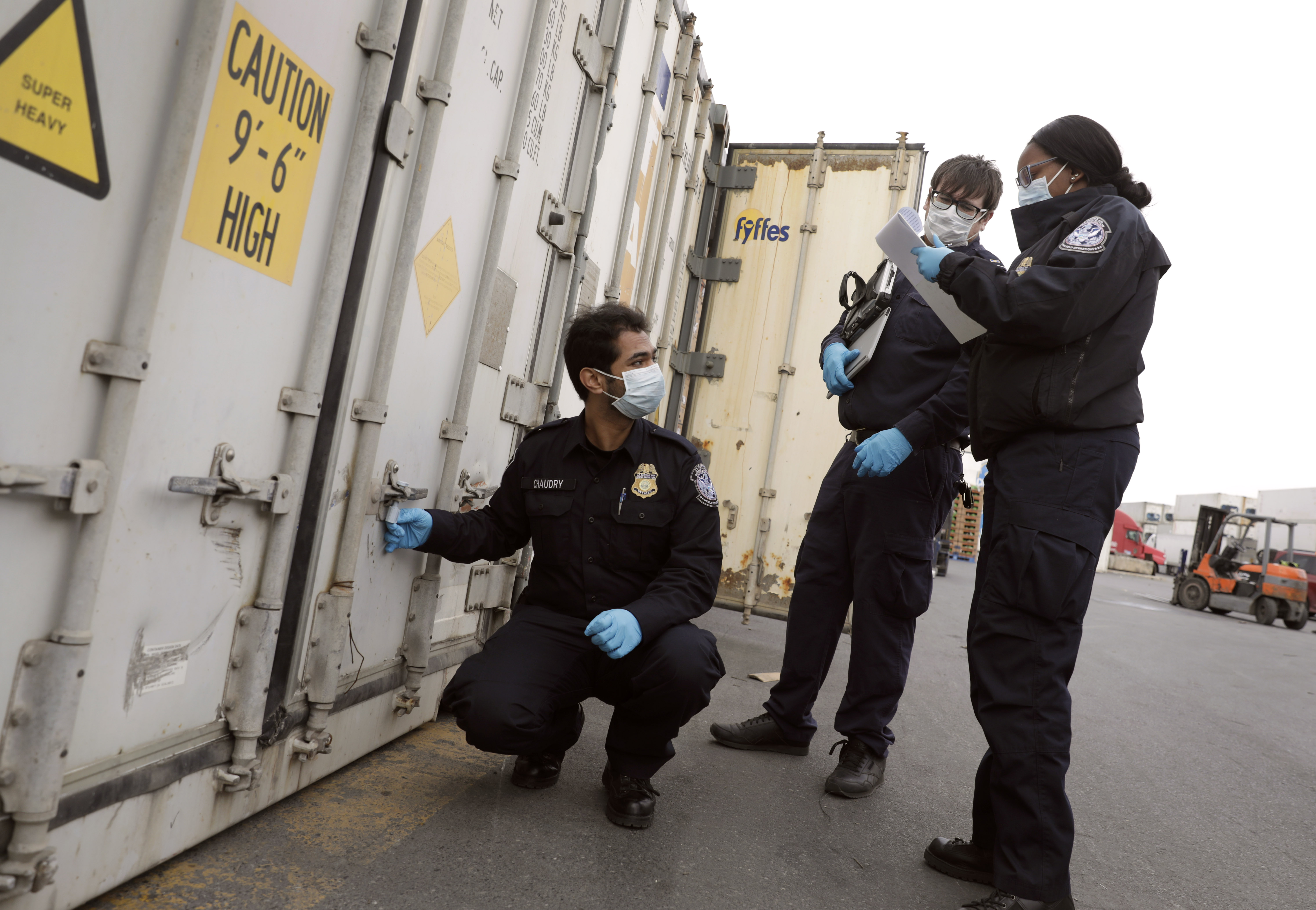
CBP agricultural specialists prepare to inspect a container of fruit shipments arriving at a port in Pennsylvania, April 16, 2020. CBP photo by Glenn Fawcett
For CBP’s Office of Field Operations, it was a year of marked increases and decreases. While international arrivals were down significantly due to travel restrictions, the food and medical supplies kept coming into the country in high quantities, while the more illicit items, such as deadly drugs, also spiked.
Abel Serrano is CBP’s branch chief for agriculture air cargo at the Miami International Airport, which processes 63% of all the perishable commodities coming to the nation by air.
Serrano said they made sure the agriculture specialists and CBP officers who handled food imports were also well protected, wearing the gloves, face masks and protective clothing they normally would don, even without a pandemic.
“Our mission’s still the same. We were ready for something like this to happen,” Serrano said, citing previous pandemics, such as the bird flu and African swine fever in the last couple of decades, when CBP first established rigorous pandemic plans. “Every year, we have different situations, but this one is the biggest one. We make sure our inspectors are safe,” ensuring all wear prescribed personal protective equipment in the correct way. “We do certifications every year and wear it every day to avoid any contamination problems.”
It was a scene being repeated at hundreds of ports of entry – land, water and air – across the country: a cadre of CBP officials making sure the food Americans want and need made it into the country and was safe for consumers.
“We can’t shut down the economy; we need to facilitate the movement of goods coming in and out,” Ferrara said. “During the pandemic, we saw an e-commerce boom. Many, including me, were using it more. Like the first time I ordered groceries online to be delivered to my house. We, CBP, had to adjust our approach to processing e-commerce related goods to make sure we weren’t slowing their movement.”
The changes in how CBP operated were crucial for the lives of the American public and the U.S economy itself.
“Our nation’s security includes both our economic security and our physical security,” Ferrara said. “The two cannot be separated.”
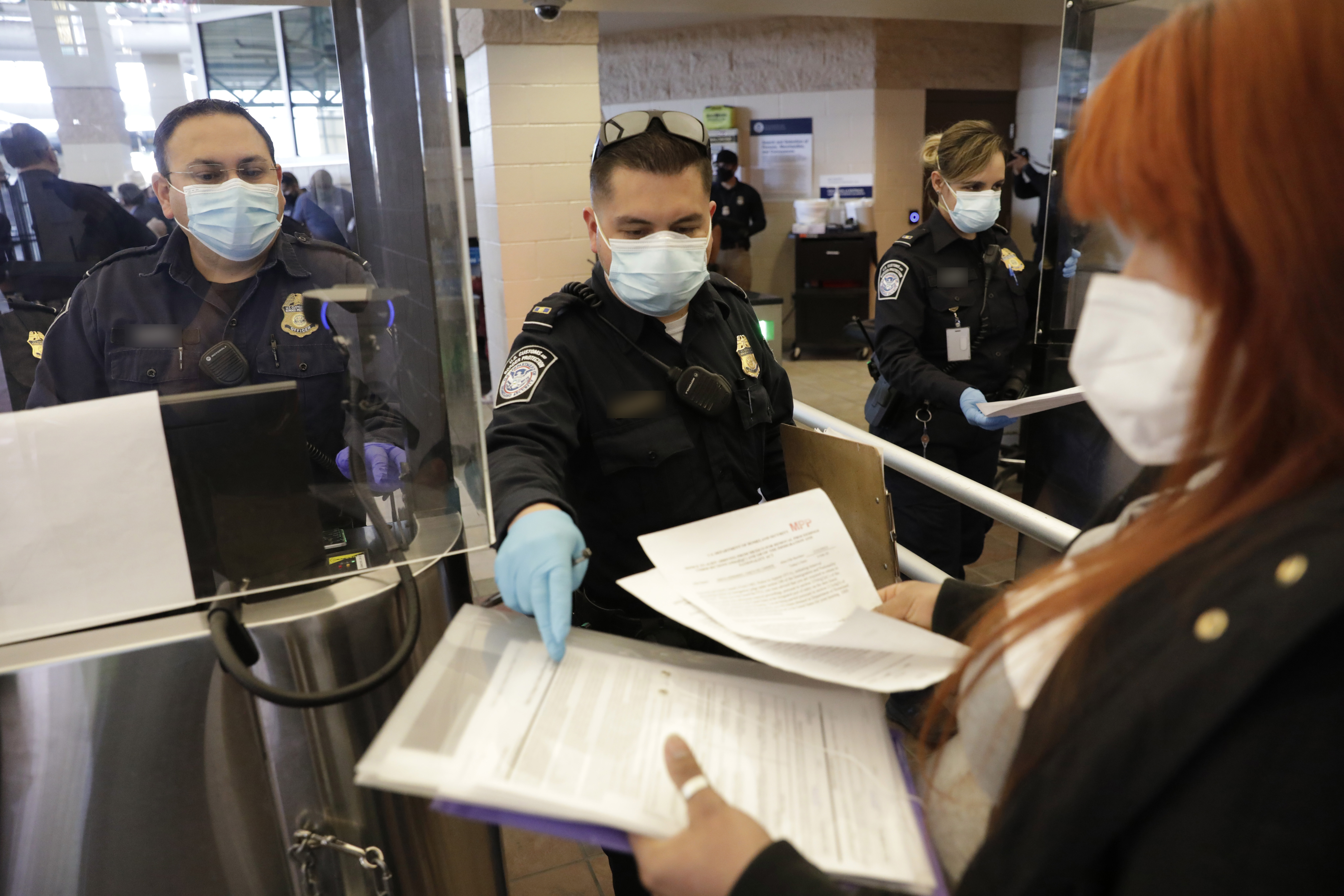
CBP officers process a small group of asylum-seekers who have active applications under the Migrant Protection Protocols in El Paso, Texas, Feb. 26. CBP photo by Glenn Fawcett
He pointed out the drop-off in the number of international travelers coming into the U.S. allowed CBP to shift resources to conducting more cargo screening.
Working hand-in-glove with the Office of Field Operations was CBP’s Office of Trade, which facilitates legitimate trade, enforces law, and protects the American economy to ensure consumer safety and to create a level playing field for American businesses. The office had to adjust quickly to a precipitous fall in international commerce after just going through a decade in which trade increased more than 34%.
“The Office of Trade was nimble in our response to the challenges posed by the pandemic,” said Alice Kipel, Trade’s acting deputy executive assistant commissioner. “We understood and continue to understand that we cannot let a global pandemic stand in the way of the trade mission.”
She pointed to many different ways her office had to shift gears to operate in the new normal of the pandemic: from internal changes, such as having approximately 95% of the office switch to telework practically all the time, to giving temporary duty relief – to the tune of more than $574 million in March and April of 2020 – for nearly 3,000 U.S. businesses to help them stay financially viable during an economic downturn, to working to make sure real COVID products made it into the U.S. – while counterfeits that could be dangerous to consumers were kept out. All of these – and more – were missions that needed to be done and done quickly.
“Trade is the lifeblood of the American economy in so many different ways,” Kipel said. “Disruption in global supply chains … threatened the livelihoods of American businesses, workers and the economy at large,” adding those disruptions had ripple effects throughout the global economy as well, “So we knew we needed to move quickly to do as much as we could to help everyone adjust as quickly as possible.”
To this end, the Office of Trade worked tirelessly with partner government agencies, such as the Federal Emergency Management Agency, Food and Drug Administration, U.S. Department of Agriculture and more to expedite clearance of large-scale shipments of critical medical supplies and personal protective equipment to ensure hospitals across the U.S. received necessary supplies as quickly as possible. And making sure counterfeit COVID-related items – medicines, disinfectants, masks, gloves, test kits, etc. – didn’t make it through and taint the pool of legitimate COVID items also meant those materials would actually save lives, instead of endangering them. To do all this, one thing the people at the ports of entry needed was good intelligence about possible threats coming in.
“We started tracking the seizures, identifying the trends, looking at all sources of information, to develop reports that could inform senior leaders,” and those in the field, so agency-wide policies, enforcements and actions could be well-coordinated and ahead of those who intended to try to take advantage of the situation, said Chris Yonkman, branch chief for trade field intelligence. He added it’s not a new task for them to do. “It is our focus: the development of finished informational and intelligence products. The focus just became much more on the pandemic.”
Trade’s intelligence division worked across components within CBP and with agencies outside of CBP and even foreign governments. Working with CBP’s Office of International Affairs, the agency’s trade arm participated in joint operations with the World Customs Organization – a group of more than 180 customs member-administrations from around the globe that ensures international standardized customs procedures to facilitate trade, secure fair revenue collection, and protect society. Through the organization’s Operation STOP, targeting illicit trade in counterfeit, substandard, and non-approved goods related to the pandemic, there were nearly 1,700 global seizure cases, including the U.S. seizing 61 cases of non-FDA compliant COVID-19 test kits. Outside of the World Customs Organization, Kipel pointed to the seizures totaling, as of the end of February, more than 177,500 nonapproved COVID test kits, more than 30 million counterfeit face masks, and tens of thousands of nonapproved medical treatments, just to name a few of the items CBP intercepted.
Yonkman said criminals are always looking to make a buck without regard to the public’s actual safety.
“It’s important that CBP is identifying intelligence that can inform operations and get these goods out of the supply chain so they don’t end up in the hands of consumers,” he said.
“There are always those who take advantage of the situation,” Kipel added. .
She also pointed to how her office moved to a more virtual environment, with conference calls and virtual meetings with all stakeholders – including fellow U.S. government agencies, trade groups and importers – so everyone could stay caught up safely with the latest developments as the pandemic progressed and changed itself.
“We stayed connected so that we know what the problems are and what our stakeholders are experiencing so that we could come up with creative solutions to help them and help us manage the flow of trade and keep trade moving,” she said, also meaning that CBP trade representatives spent a lot of late nights and early mornings to make those Teams meetings. “That’s what we needed to do to adjust to keep trade going.”
Keeping the nation fed and protected with medical supplies was just half the story. CBP also had to stop drugs from pouring across the border. The agency’s efforts were helped by the sharp reduction in personal vehicles – which carried more and smaller loads – coming through the ports of entry and the rise in commercial trucks loaded down with larger quantities of drugs. Many CBP officers were transferred from the personal owned vehicle traffic lanes, where they were trying to screen thousands of cars and trucks every day, to commercial truck operations, where the numbers might be in the dozens. Fewer targets meant more hits, and those hits were larger because they were in tractor-trailers, and not hidden in a trunk or body panels of a car.
“With that change of workload, we were able to keep our enforcement focused and continue to have individuals work the commercial environment,” who would normally work personal vehicles, said Stephanie Watson, acting director of Tactical Operations for the Office of Field Operations. But she was quick to point out drugs coming in personal cars, trucks and SUVs saw an uptick again. “We’re still getting a significant number of seizures out of [personally owned vehicles].”
Without tipping their hand at how CBP knows smugglers are changing their tactics, Watson did say the agency adjusted to the changes the crime bosses tried to make.
“The criminal organizations will smuggle whatever folks want, and they will try to have diversified ‘business interests,’” she said. “When they attempt to do that through or between our ports of entry, we in CBP work very hard to detect, intercept, identify and prosecute those individuals who are doing so. We strive to stay one step ahead of our adversaries.”
Ferrara also pointed to the work by CBP’s Operation Support, which he headed for a time during the past year. To make sure all CBP frontline personnel had what they needed and the knowledge to protect themselves, Dr. David Tarantino, CBP’s chief medical officer, worked closely with CBP human resources and safety and health professionals.
“CBP developed a comprehensive, mission-specific, risk-based job hazard analysis and personal protective equipment assessment,” Tarantino said. “This analysis is based on guidance from the Department of Homeland Security, CDC and other experts.”
Guidance from CBP, Homeland Security and the Centers for Disease Control and Prevention is available to all CBP employees through an internal agency website. Much of the information is the same as the general public has been hearing – wash your hands frequently and for 20 seconds with soap and water, recognize the signs of COVID-19, and practice social distancing, among others. In addition, it advises CBP employees what they should do for protective equipment: gloves, face masks and respirators for direct contact with high-risk passengers down to maybe just good hygiene techniques for those in offices or working from home.
CBP also stood up an emergency operations center at agency headquarters in Washington, D.C., on March 1, 2020. Staffed by experts from components throughout CBP, it supports the agency's planning and response to the coronavirus and assists people in the workforce.
"When we stand up an operation such as this, it's in response to a major event," said Dario Lugo, operations manager for the center. "Our main concern is the safety of CBP personnel in the field and their families. The accountability of our staff is paramount. This is not unlike how we respond to hurricanes, floods, or other acts of nature."
“There are a lot of heroes in [Operations Support] who did yeoman’s work to make this agency successful,” Ferrara said.
Keeping an Eye on the Sky … and the Water
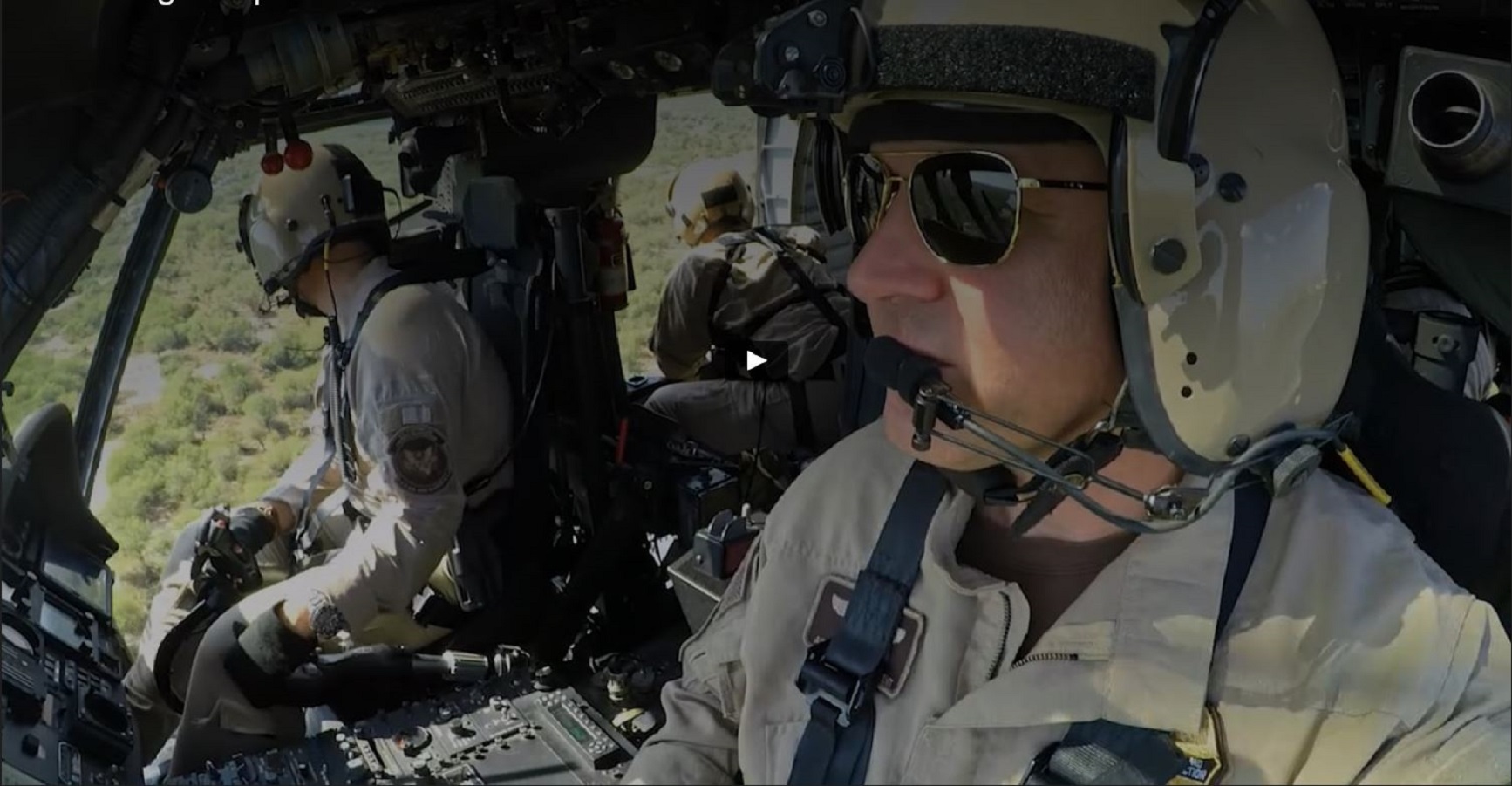
Deputy Director of Air Operations J.P. Pridgen and Air Interdiction Agent Shawn Jones from the McAllen Air Branch conduct patrol operations in a UH-60 Black Hawk helicopter near Mission, Texas. Photo by Rod Kise
Air and Marine Operations – CBP’s component that controls the air spaces and waterways along the border and beyond – had its work cut out for it as well.
“The bad guys never let a crisis go to waste. They’re always trying to find ways to exploit weaknesses in our defense,” said Keith Jones, executive director, Air and Marine Operations, Southwest Region, an area of the U.S.-Mexico border that stretches nearly 2,000 miles and covers the rivers, deserts and sea waters between the two countries from the Gulf of Mexico to the Pacific Ocean. “Our folks are going out there and stepping up every day, working with [Border Patrol and Field Operations] folks on the ground.”
To make sure no one did take advantage of the COVID-19 crisis, flights along the Southwest border, including its maritime approaches, increased since much of the social distancing and isolation started. Jones said that’s actually been a product of one of the ways his division implemented social distancing at work: spreading personnel more broadly across the 24-hour workday and seven-day calendar week, creating distance between crews. The added distance between crew members permitted greater use of limited assets, and thus, more flights. In fact, for a period immediately following the implementation of those policies, Air and Marine Operations increased flight hours along the Southwest border by nearly 15%.
“Our personnel really focused on applying the aviation and maritime assets more precisely, leveraging intelligence,” Jones said. “They really did a good job pulling it all together to achieve those results.”
The extra time in the air made for a difference not lost on the people who worked those flights.
“We’re actually able to increase our footprint,” Smith said. “Not only at the office and mitigate people working in close proximity [with each other], but also creating more of a footprint out there on the line adding additional layers of coverage.”
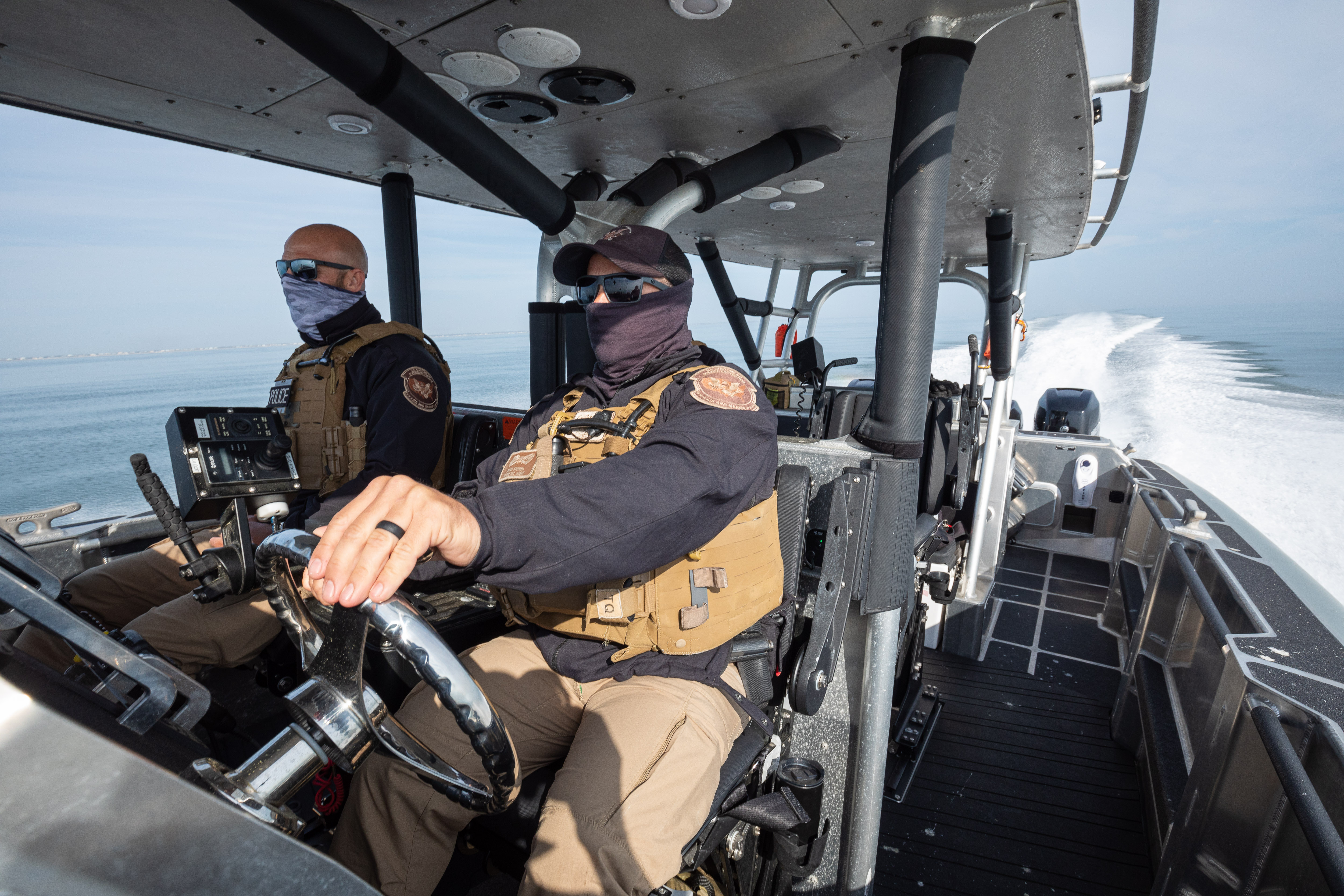
San Diego Air and Marine Operations’ 41-foot Coastal Interceptor Vessel operates in the Pacific Ocean. Photo by Mani Albrecht
On the water, Air and Marine Operations also saw certain benefits from the lack of pleasure boats on the seas because of local restrictions and lockdowns. The fewer the boats out there, the fewer agents had to keep their eyes on, making it easier to check the handful of ones they encountered during the lockdown periods. Plus, with fewer boats out there to watch and more patrols to watch them, it was easier for one boat crew to hand off a monitored subject to another Air and Marine Operations crew further up the coast. For example, the Air and Marine boat crews didn’t have to drive their vessel north from San Diego to Oceanside, California, a trip that would normally take about an hour of pounding on the Pacific Ocean swells, because they knew they had more agents up there.
Overall, the pandemic might have actually given Air and Marine Operations an upper hand in protecting the border.
“The flexibility of spreading our forces across the clock gave us the flexibility to deploy forces when and where needed,” Jones said. “Being able to spread our shifts gave us a lot more possibilities to sync our operations with the bad guys’ schedule. It’s really not much more complex than that. We’ve realized some efficiencies; we’ve realized some of the things actually allow us to be more effective in our operations. And if it isn’t broke, let’s not fix it.”
Jones added that maintaining – and even increasing – Air and Marine Operations along the border during this time of COVID speaks volumes of the character of the men and women he works with.
“It’s a testament to the dedication of our workforce,” he said. “It’s revealed our character and resolve to protect the homeland. But also [a testament to] the compassionate side: when our folks are experiencing great personal tragedy, yet they have no hesitation when it comes to helping folks in need.”
COVID Didn’t Mask the Need for New Officers and Agents
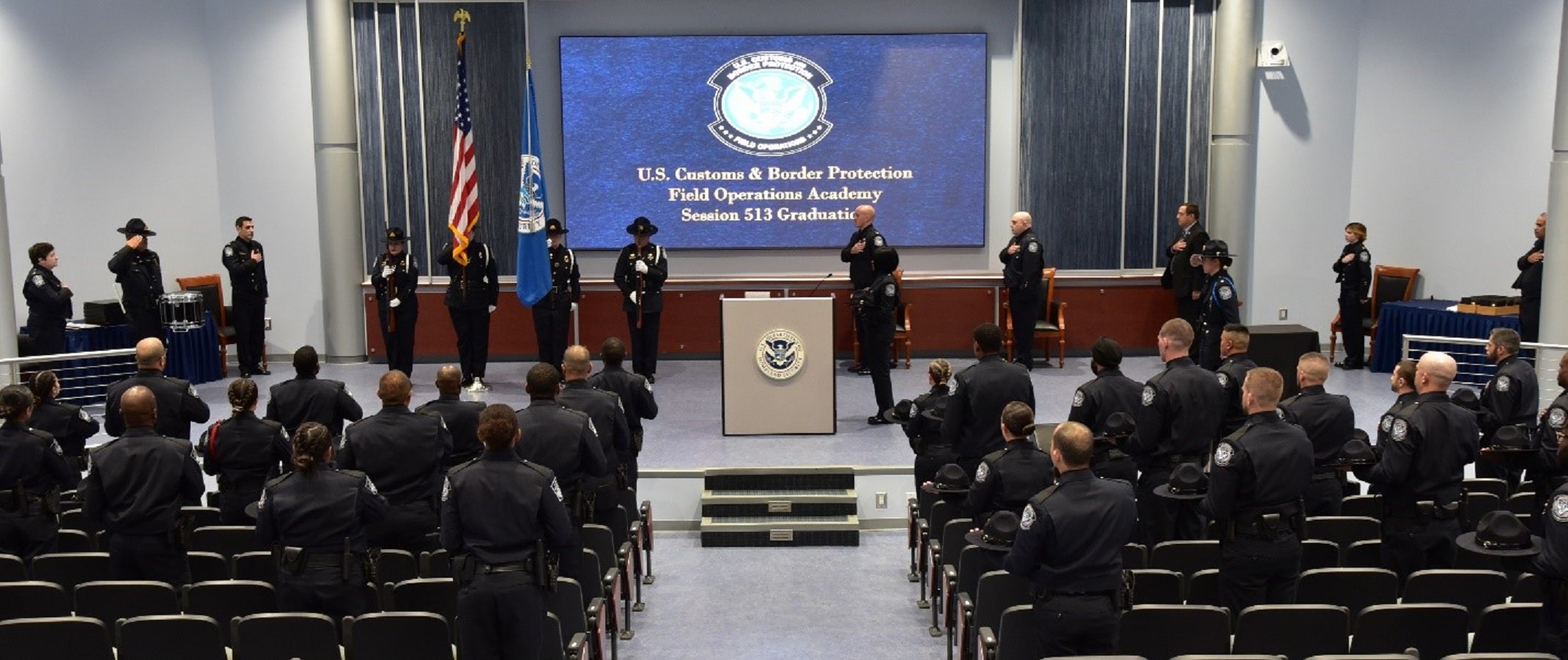
The Field Operations Academy in Glynco, Georgia, graduates a class of some of the newest CBP officers during a ceremony July 21. Photo by Supervisory CBP Officer Osama Khan
The increased demands on border security and port operations meant that the pipeline of new agents and officers coming into CBP couldn’t just be closed off. Starting in late March of 2020, the COVID-19 crisis paused training at CBP’s academies for nearly three months (see the CBP feature article, “Academies Closed, but Learning Continues”), sending 1,703 trainees across three basic training academies and many more veteran agents and officers who were taking advanced training home within a 48-hour period.
“We went from 100% capacity at every location to zero within a week,” said Assistant Commissioner Christopher Hall, in charge of all of CBP’s training.
During the shutdown period, while most of CBP’s Office of Training and Development’s uniformed instructors were deployed to the Northern Border, numerous discussions occurred about the practicality of distance learning in law enforcement training. A new operating plan was put in place to adjust to the current environment, and about 1,700 trainees returned between June and August to resume training to CBP’s Air and Marine Operations Academy, Field Operations Academy, and Border Patrol Academy with new health and safety protocols in place, including new social distancing rules.
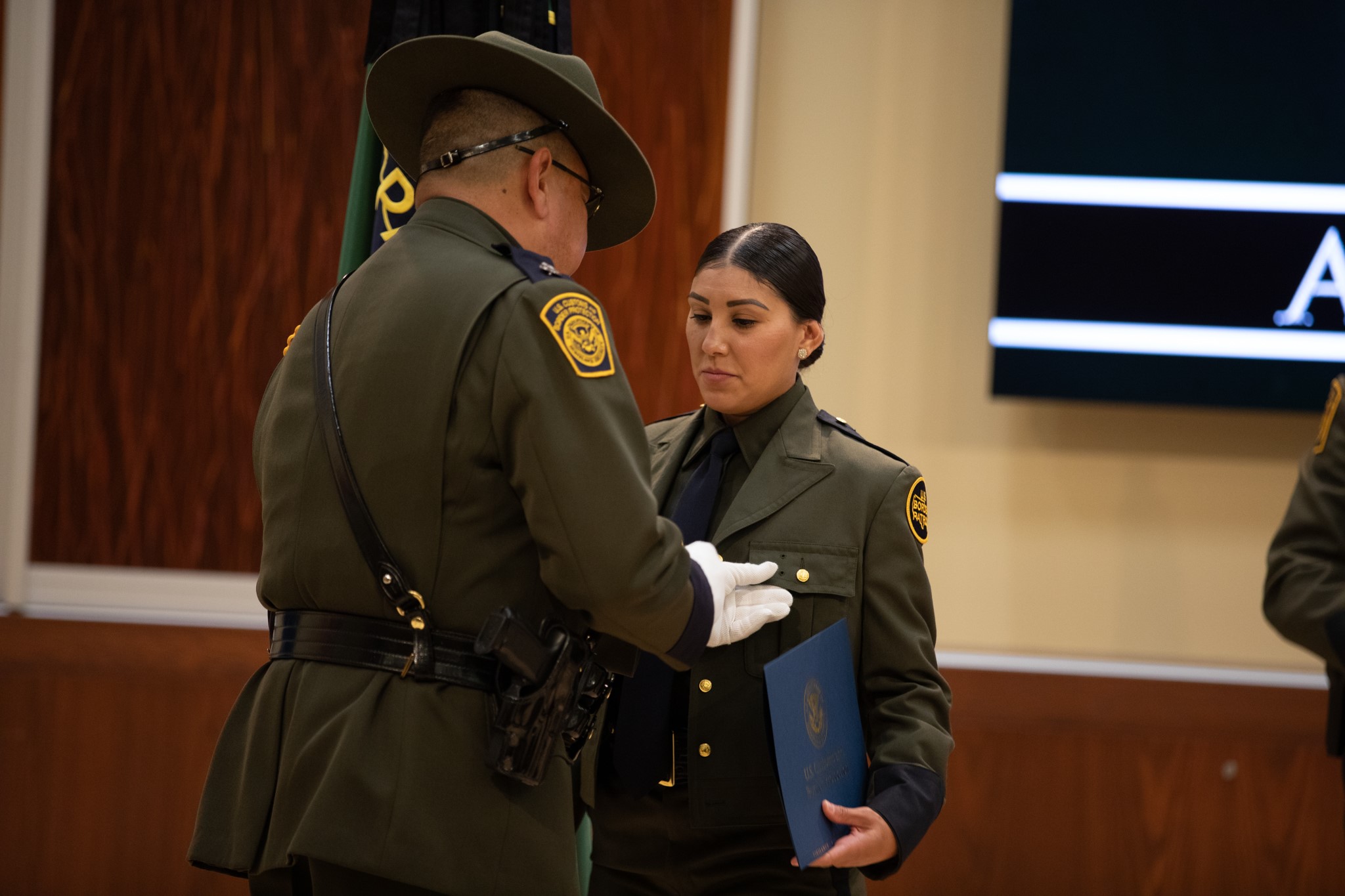
Border Patrol Agent Lorraine Partida receives her badge during graduation from the Border Patrol Academy in Artesia, New Mexico, July 21. Photo by Border Patrol Academy StratComms Division
It made for a long and twisting journey for new Border Patrol Agent Lorraine Partida. As a senior Border Patrol agent pinned the badge on Partida during a graduation ceremony at U.S. Customs and Border Protection’s Border Patrol Academy in Artesia, New Mexico, on July 21, Partida, who now works in Laredo, Texas, couldn’t help but think about how she finally got there. Partway through her training, everything stopped, and she was sent home, due to COVID-19.
“Everything was a rush,” she said, as she recalled how she had to pack up her belongings in late March 2020, to try and continue some kind of semblance of training at home in Harlingen, Texas, and then come back to a much different Border Patrol Academy in June. “It was tough to come back. But I had the support from my class and had the support from my family, and now we’ve finally graduated.”
Meanwhile, halfway across the country, new CBP Officer Alia Burton, who also saw her training paused in March 2020 and resumed in June, could see her future as she crossed the stage during graduation ceremonies at the Field Operations Academy in Glynco, Georgia, this past summer.
“It helped me to expect the unexpected,” said Burton, who went to Baltimore International Airport after her training. “It opened up my eyes to what it would be like to be with CBP.”
The pandemic also brought some unexpected – but welcome – changes to how CBP’s training is now conducted. For example, instead of just one location for the Field Operations Academy, CBP now offers basic training for its new officers in three different locations, helping the agency by offering more choices should future pandemics, hurricanes or whatever natural disasters hit again. Hall said having basic training up and running at three different locations was inconceivable a year ago. He pointed to this change as just one example of how his team operated outside of the box to meet mission needs while successfully training under the pandemic environment as safely as possible.
“Learning what we could teach distantly and what we train in alternate locations to do our training built an organizational resilience for us,” Hall said. “We’ve learned through the trials and tribulations of COVID that we need to have better facilities [that can operate in any circumstances]. We learned what we can do in different ways and different locations to meet the needs of the field, which are not static. COVID gave us the opportunity to go back and look at how we do business and do it better.”
Providing an Unprecedented Response for an Unprecedented Time
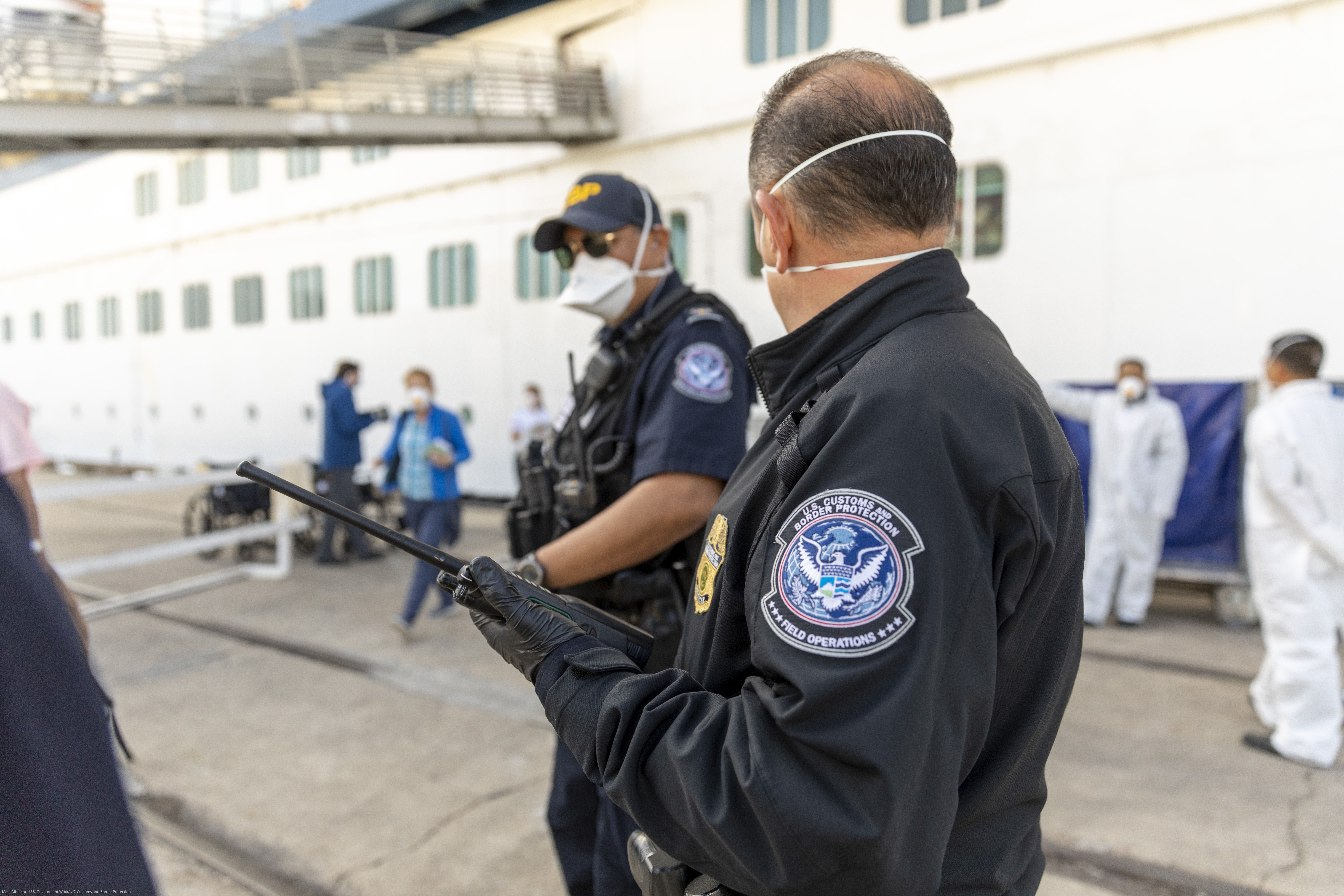
Passengers onboard a cruise ship disembark in San Diego and are transferred by busses directly to a passenger jet waiting for them. CBP officers from the San Diego Field Office assisted in the secure transfer of the passengers. Photo by Mani Albrecht
While responses to Avian flu and Ebola might be looked at as possibly helping teach some valuable lessons all of CBP could apply to the COVID pandemic, Ferrara said the past year was unlike anything CBP had ever faced.
“There’s nothing, nothing in our lifetimes that compares to what we went through,” Ferrara said, pointing out the last pandemic of this scale was 100 years ago with the Spanish flu in 1918. “Transportation was different at that time; people were more local than global.”
He added COVID-19 reaffirmed and deepened an already great respect he has for the people of CBP and their resiliency. “They still go to work every day knowing what they face at work and what their families face at home, and they still do it. Our folks still lean their shoulders into it and get it done,” Ferrara said.
Smith said the air and marine crews will continue to climb in their planes, helicopters and boats to keep an eye on an always changing border situation, regardless of what diseases are in play.
“Every day, we see the same thing,” he said. “Sometimes it’s just more in one area. It’s a lot to juggle, and we’ll continue to do it. I think we’ve managed as best as we’ve been able. We manage and push forward, because we have a job to do, and we have to be safe in what we do.”
Back in South Texas, Moreno walked the border area not far from the Rio Grande and contemplated a future that might be free of COVID-19, but still expected to have to intercept the people who immigrate illegally into this country, as well as the drug smugglers that try to sneak through.
“We’re dealing with what is presented to us. Our agents work around the clock to do the best that we can with what we have,” he said. “We’re going to do our job, and we’re going to do it to the best of our ability.”


